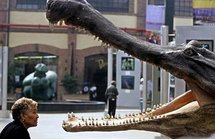
"These species open a window on a croc world completely foreign to what was living on northern continents," said National Geographic explorer-in-residence Paul Sereno.
The beasts inhabited the southern land mass known as Gondwana about 100 million years ago, and the fossils were found in a series of expeditions launched to the Sahara from 2000 onwards.
Significantly, Sereno's team found the five oddball crocs had long legs allowing them to walk upright like mammals rather than slither with their bellies to the ground.
That gave them speed during hunting and when they fled from danger to seek refuge in the water.
The mightiest of the newfound crocs, BoarCroc, was a 20-foot-long (six-meter) "saber-toothed cat in armor" that ate dinosaurs for dinner, National Geographic said on its website.
It won its name because its three sets of fangs jutted out from its jaws giving it an appearance a little like a boar.
PancakeCroc would lie for hours in the water waiting for fish to swim into its flat, three-foot (one-meter) long mouth, lined with rows of spiky teeth, while RatCroc had a snub nose and buckteeth for rooting in the ground.
"There's an entire croc world brewing in Africa that we really had only an inkling about before," Sereno said on the website.
The expedition first found examples of SuperCroc, whose existence was already known, and weighed in eight tons, measuring some 40 feet (12 meters), before then discovering the others.
"Many of the fossils were found lying on the surface of a remote, windswept stretch of rock and dunes. The crocs galloped and swam across present-day Niger and Morocco when broad rivers coursed over lush plains and dinosaurs ruled," National Geographic said.
The crocs also will star in a documentary "When Crocs Ate Dinosaurs" on the National Geographic Channel.
----------------------------------------------------------------------------------------------------------------------------------
Image: A woman by a crocodile display in 2001 in Mexico (AFP/File/Jorge Uzon).
The beasts inhabited the southern land mass known as Gondwana about 100 million years ago, and the fossils were found in a series of expeditions launched to the Sahara from 2000 onwards.
Significantly, Sereno's team found the five oddball crocs had long legs allowing them to walk upright like mammals rather than slither with their bellies to the ground.
That gave them speed during hunting and when they fled from danger to seek refuge in the water.
The mightiest of the newfound crocs, BoarCroc, was a 20-foot-long (six-meter) "saber-toothed cat in armor" that ate dinosaurs for dinner, National Geographic said on its website.
It won its name because its three sets of fangs jutted out from its jaws giving it an appearance a little like a boar.
PancakeCroc would lie for hours in the water waiting for fish to swim into its flat, three-foot (one-meter) long mouth, lined with rows of spiky teeth, while RatCroc had a snub nose and buckteeth for rooting in the ground.
"There's an entire croc world brewing in Africa that we really had only an inkling about before," Sereno said on the website.
The expedition first found examples of SuperCroc, whose existence was already known, and weighed in eight tons, measuring some 40 feet (12 meters), before then discovering the others.
"Many of the fossils were found lying on the surface of a remote, windswept stretch of rock and dunes. The crocs galloped and swam across present-day Niger and Morocco when broad rivers coursed over lush plains and dinosaurs ruled," National Geographic said.
The crocs also will star in a documentary "When Crocs Ate Dinosaurs" on the National Geographic Channel.
----------------------------------------------------------------------------------------------------------------------------------
Image: A woman by a crocodile display in 2001 in Mexico (AFP/File/Jorge Uzon).









 Home
Home Politics
Politics









